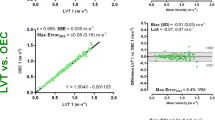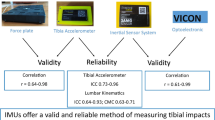Abstract
Knowledge of external forces acting on an athlete is often required to study performance and injury mechanisms, but direct measurements are difficult to obtain. While transducers in the rings cables typically measure external forces experienced by gymnasts performing static balances and swinging movements on rings, this solution is not always acceptable and an accurate technique that does not hinder the gymnasts’ performances is desirable. This study evaluates a video-based technique for estimating cable tension on the rings apparatus. Static loading of a rings frame coupled with a planar video analysis of the mandatory damped elastic devices (DEDs) provided a tension-deflection calibration curve. Three-dimensional video and cable tension data were obtained for two male gymnasts performing static balances and dynamic swinging movements. Cable tension was measured using a force link while a planar video analysis determined time histories of the DED deflections. Combined cable tension time histories were estimated fromrelative DED deflections coupled with the tension-deflection calibration curve and the orientation of the rings cables, and were compared to measured values to evaluate the proposed technique. For static balances the RMS difference between measured and estimated combined cable tension was 83 N. For dynamic swinging movements the maximum RMS difference was 189 N, equivalent to a 4% difference when expressed as a percentage of the peak value. The indirect video-based technique developed in this study accurately estimates combined cable tension throughout movements on rings and may be considered for studies where a remote measurement is required. There is potential for the technique to be extended to other sporting situations, where indirect accurate estimates of external forces acting on an athlete are needed.
Similar content being viewed by others
References
Abdel-Aziz, Y.I. & Karara, H.M. (1971) Direct linear transformation from comparator coordinates into object space coordinates in close-range photogrammetry. InASP Symposium on Close Range Photogrammetry. American Society of Photogrammetry, Falls Church.
Brewin, M.A. & Kerwin, D.G. (2003) Accuracy of scaling and DLT reconstruction techniques for planar motion analyses.Journal of Applied Biomechanics,19, 79–88.
Brewin, M.A., Kerwin, D.G. & Yeadon, M.R. (1999) Indirect estimation of peak cable tension during longswings on rings.Journal of Sports Sciences,17, 3.
Brewin, M.A., Yeadon, M.R. & Kerwin, D.G. (2000) Minimising peak forces at the shoulders during backward longswings on rings.Human Movement Science,19, 717–736.
Kerwin, D.G. & Hiley, M.J. (2003) Estimation of reaction forces in high bar swinging.Sports Engineering,6, 21–30.
Kopp, P.M. & Reid, J.G. (1980) A force and torque analysis of giant swings on the horizontal bar.Canadian Journal of Applied Sports Science,5, 98–102.
Mills, S.H. (1998) Indirect measurement of forces on the gymnastics rings. In H.J. Riehle & M.M. Vieten (eds),Proceedings of the XVI International Symposium on Biomechanics in Sports. University of Konstanz: ISBS, pp. 192–195.
Nissinen, M.A. (1983) Kinematic and kinetic analysis of the giant swing on rings. In H. Matsui & K. Kobayashi (eds),Biomechanics VIII-B. Champaign, IL: Human Kinetics, pp. 781–786.
Sale, D.G. & Judd, R.L. (1974) Dynamometric instrumentation of the rings for analysis of gymnastic movements.Medicine and Science in Sports,6, 209–216.
Walton, J. (1981) Close-range cine-photogrammetry: a generalised technique for quantifying gross human motion. Unpublished Ph.D. Dissertation, Pennsylvania State University.
Author information
Authors and Affiliations
Corresponding author
Rights and permissions
About this article
Cite this article
Brewin, M.A., Kerwin, D.G. Indirect estimation of cable tension during gymnastic movements on rings. Sports Eng 6, 177–185 (2003). https://doi.org/10.1007/BF02859894
Issue Date:
DOI: https://doi.org/10.1007/BF02859894




